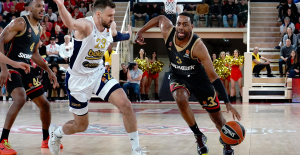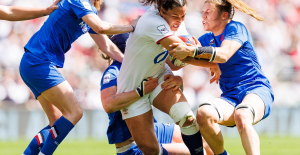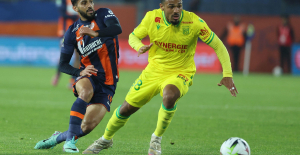You have to put up with a lot even for the journey. First a car ride from Tromsø, then by ferry to the island of Rebbenesøya, finally on foot in the dark on snowshoes through the arctic winter cold. And yet the real adventure hasn't even begun when you finally reach the remote Arctic Elements Camp in northern Norway: the night-time aurora hunt in a kayak. What the surroundings really look like can only be guessed at. Beyond the cone of light from the headlamp, everything is black.
Where are you right now? Difficult to say before your eyes adjust to the extreme darkness. Only slowly, as if one were discovering the area in individual jigsaw pieces, are at least outlines of the arctic landscape recognizable in the pale moonlight: the barren environment of islands, islets and rocky hills. The North Sea is pitch black except where the moon is reflected in the waves. The camp's dimly lit yurts soon disappear from view. Guide Lise Haug, who forms the advance party, is something like the headlamp fixed star.
But it's not just dark outside on this winter evening. It's icy too. A lot. The scale of the thermometer has slipped into the double-digit minus range, at times it shows minus 21 degrees. The air is correspondingly crisp and dry. However, the small group is not deterred by this. Finally, there is a unique chance to see real Northern Lights dancing in the sky. Not in the warm bus or in the car, not even on snowshoes, but in a completely different way - on the icy water in a kayak.
In return, in addition to the arduous journey, you also have to put up with cold feet and hands. And hopes that the yurts in which you will be staying later will be reasonably heated. A carpenter from the island was skeptical: "Only the fish sleep outside in this cold weather," he announced with a laugh on the ferry. For him, for whom the northern lights are part of everyday life, it was incomprehensible that someone would come to the north of Norway in the inhospitable winter just to experience the luminous natural phenomenon in the sky once in their life - and that with a tent and kayak.
It is still cloudy when we arrive at the camp. The chances of a green, maybe even red dance of lights in the winter sky should still be quite good this evening, says Lise Haug. At least the forecast apps on your smartphone promise increased Northern Lights activity. "Category 4 - that's pretty strong," explains the native Swede.
The surroundings are also ideal for observations: on the remote island there are almost no lights from street lamps or houses that could weaken the visibility of the so-called Aurora Borealis - especially not so late at night.
But the unusual paddling excursion first requires intensive preparation. It starts with arming yourself against the cold. First put on several layers of functional clothing, then laboriously squeeze into the tight dry suit, finally slip into the gloves and put on the hat. Half an hour later, when everyone is ready to go, there are still a few clouds hanging over the stars.
Nevertheless, it goes out, into nature, on the water. After Lise Haug has poured hot water into the neoprene gloves of the heavily packed midnight paddlers, she pushes the kayaks from the shore into the sea. Paddle off under the inky black night sky.
Again the eyes have to get used to the total darkness. This takes a few minutes, but then even the headlamps can remain switched off. The kayaks are stable on the pleasantly calm water surface today, and even if you capsized, the suits would keep you warm, the expedition leader reassured.
Carefree and with leisurely moves, everyone glides through the polar night. The clouds have since cleared apart from a few bands. The stars are now glowing in the sky, the ice encrustations of the algae are glistening in the water. No sign of the Northern Lights. A few wild swans are startled by the kayaks.
“During the day you can see many animals while paddling here – seals, otters, all sorts of bird species: from puffins to herons. At night you only sometimes see the eyes of otters on the bank shining, that's all," says Lise Haug, as the shadows of swans fly away clamoring and are soon swallowed up by the darkness. Otherwise it is quiet, only occasionally a soft sloshing can be heard.
Paddling continues like this for a while - and then, shortly before the return, the hoped-for climax lights up in the sky, as if ignited by magic. At first the northern lights are only moderately intense and don't really want to start dancing, but at least you can see them. But then the green streaks of light become more intense and literally dance between the twinkling stars. A goosebump moment!
However, capturing him with photos is difficult in this situation. It's too shaky on the kayak. Getting out and wiggling through the ice water to shore is tedious and, with the equipment, also risky. Some try. But above all, it is important to take in the exceptional moment, to enjoy the happiness of this unique polar cinema.
In contrast to the Northern Lights tours in and around Tromsø, where larger groups often go hunting, polar paddling is exclusively for a small audience. Everyone gazes devoutly at the glowing night sky for quite a while.
For a long time you don’t feel the cold because of all the adrenaline, but at some point icy hands, feet and nose report to your brain: It’s time to paddle back and crawl under the thick feather beds in the yurt – luckily it’s warm from the oven, also because it’s the return to Tromsø early the next day.
After getting up, just in time for the car to drive back, the morning sun bathes the area in a blue twilight and makes the landscape recognizable for the first time, which one could not really perceive hours before. In this way, the individually saved puzzle pieces of the night are put together to form a large panorama of the sea, barren rocky coast, ice and snow.
As the intense blue is then flooded with yellow and red sunlight, daybreak looks like a continuation of the night's light show - in different colors, but just as impressive.
Arrival: For example with Lufthansa directly to Tromsø or with Norwegian or SAS via Oslo. From Tromsø by taxi in 90 minutes to the ferry terminal in Mikkelvika and further by ferry in 10 minutes to Bromnes on the island of Rebbenesøya. Elements Arctic Camp is a 15-minute walk along the coast.
Camp Experiences: The privately run Elements Arctic Camp offers arctic paddling trips, Northern Lights kayaking and overnight stays. A two-day stay for two people with winter kayaking costs 14,600 kroner (around 1313 euros), elementsarcticcamp.com. Each of the two yurts has four beds, a fully equipped kitchen and a lounge area with a hand-held stove.
More information: visittromso.no; visitnorway.de
Participation in the trip was supported by Visit Norway. You can find our standards of transparency and journalistic independence at axelspringer.com/de/Werte/downloads.
This article was first published in February 2022.

 B:SM will break its investment record this year with 62 million euros
B:SM will break its investment record this year with 62 million euros War in Ukraine: when kyiv attacks Russia with inflatable balloons loaded with explosives
War in Ukraine: when kyiv attacks Russia with inflatable balloons loaded with explosives United States: divided on the question of presidential immunity, the Supreme Court offers respite to Trump
United States: divided on the question of presidential immunity, the Supreme Court offers respite to Trump Maurizio Molinari: “the Scurati affair, a European injury”
Maurizio Molinari: “the Scurati affair, a European injury” First three cases of “native” cholera confirmed in Mayotte
First three cases of “native” cholera confirmed in Mayotte Meningitis: compulsory vaccination for babies will be extended in 2025
Meningitis: compulsory vaccination for babies will be extended in 2025 Spain is the country in the European Union with the most overqualified workers for their jobs
Spain is the country in the European Union with the most overqualified workers for their jobs Parvovirus alert, the “fifth disease” of children which has already caused the death of five babies in 2024
Parvovirus alert, the “fifth disease” of children which has already caused the death of five babies in 2024 Inflation rebounds in March in the United States, a few days before the Fed meeting
Inflation rebounds in March in the United States, a few days before the Fed meeting Video games: Blizzard cancels Blizzcon 2024, its annual high mass
Video games: Blizzard cancels Blizzcon 2024, its annual high mass Falling wings of the Moulin Rouge: who will pay for the repairs?
Falling wings of the Moulin Rouge: who will pay for the repairs? “You don’t sell a company like that”: Roland Lescure “annoyed” by the prospect of a sale of Biogaran
“You don’t sell a company like that”: Roland Lescure “annoyed” by the prospect of a sale of Biogaran Exhibition: in Deauville, Zao Wou-Ki, beauty in all things
Exhibition: in Deauville, Zao Wou-Ki, beauty in all things Dak’art, the most important biennial of African art, postponed due to lack of funding
Dak’art, the most important biennial of African art, postponed due to lack of funding In Deadpool and Wolverine, Ryan and Hugh Jackman explore the depths of the Marvel multiverse
In Deadpool and Wolverine, Ryan and Hugh Jackman explore the depths of the Marvel multiverse Tom Cruise returns to Paris for the filming of Mission Impossible 8
Tom Cruise returns to Paris for the filming of Mission Impossible 8 Skoda Kodiaq 2024: a 'beast' plug-in hybrid SUV
Skoda Kodiaq 2024: a 'beast' plug-in hybrid SUV Tesla launches a new Model Y with 600 km of autonomy at a "more accessible price"
Tesla launches a new Model Y with 600 km of autonomy at a "more accessible price" The 10 best-selling cars in March 2024 in Spain: sales fall due to Easter
The 10 best-selling cars in March 2024 in Spain: sales fall due to Easter A private jet company buys more than 100 flying cars
A private jet company buys more than 100 flying cars This is how housing prices have changed in Spain in the last decade
This is how housing prices have changed in Spain in the last decade The home mortgage firm drops 10% in January and interest soars to 3.46%
The home mortgage firm drops 10% in January and interest soars to 3.46% The jewel of the Rocío de Nagüeles urbanization: a dream villa in Marbella
The jewel of the Rocío de Nagüeles urbanization: a dream villa in Marbella Rental prices grow by 7.3% in February: where does it go up and where does it go down?
Rental prices grow by 7.3% in February: where does it go up and where does it go down? Even on a mission for NATO, the Charles-de-Gaulle remains under French control, Lecornu responds to Mélenchon
Even on a mission for NATO, the Charles-de-Gaulle remains under French control, Lecornu responds to Mélenchon “Deadly Europe”, “economic decline”, immigration… What to remember from Emmanuel Macron’s speech at the Sorbonne
“Deadly Europe”, “economic decline”, immigration… What to remember from Emmanuel Macron’s speech at the Sorbonne Sale of Biogaran: The Republicans write to Emmanuel Macron
Sale of Biogaran: The Republicans write to Emmanuel Macron Europeans: “All those who claim that we don’t need Europe are liars”, criticizes Bayrou
Europeans: “All those who claim that we don’t need Europe are liars”, criticizes Bayrou These French cities that will boycott the World Cup in Qatar
These French cities that will boycott the World Cup in Qatar Euroleague: at the end of the suspense, Monaco equalizes against Fenerbahçe
Euroleague: at the end of the suspense, Monaco equalizes against Fenerbahçe Women's Six Nations: Where to see and five things to know about France-England
Women's Six Nations: Where to see and five things to know about France-England Liverpool: it is confirmed, Slot will succeed Klopp on the Reds bench
Liverpool: it is confirmed, Slot will succeed Klopp on the Reds bench Ligue 1: Montpellier and Nantes back to back, two reds in stoppage time
Ligue 1: Montpellier and Nantes back to back, two reds in stoppage time


















